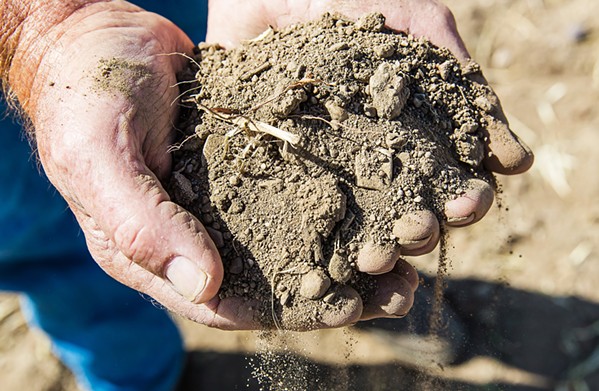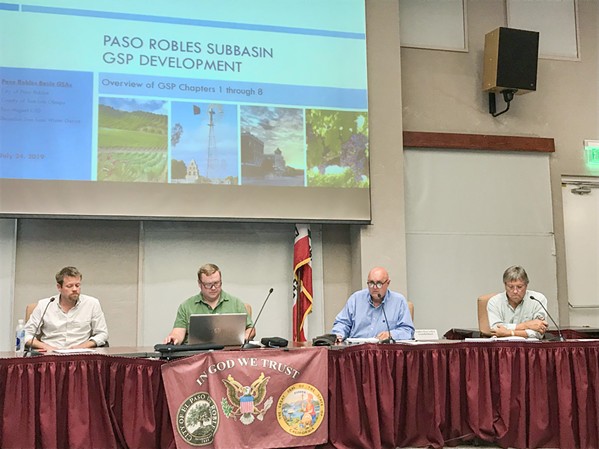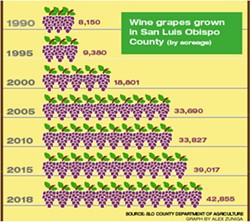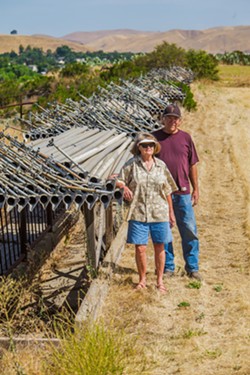Thirsty for sustainability: Is Paso Robles any closer to solving its groundwater problem?
By Peter Johnson[{
"name": "Ad - Medium Rectangle CC01 - 300x250",
"id": "AdMediumRectangleCC01300x250",
"class": "inlineCenter",
"insertPoint": "8",
"component": "2963441",
"requiredCountToDisplay": "12"
},{
"name": "Ad - Medium Rectangle LC01 - 300x250",
"id": "AdMediumRectangleCC01300x250",
"class": "inlineCenter",
"insertPoint": "18",
"component": "2963441",
"requiredCountToDisplay": "22"
},{
"name": "Ad - Medium Rectangle LC09 - 300x250",
"id": "AdMediumRectangleLC09300x250",
"class": "inlineCenter",
"insertPoint": "28",
"component": "3252660",
"requiredCountToDisplay": "32"
}]
On a blistering hot July day in San Miguel, Robert Galbraith, 68, bends down and scoops up two handfuls of dry soil. He spreads his fingers and lets the dirt fall back to his fallowed ground.
The motion is symbolic of how Galbraith feels his family farm is slipping away from him.
A San Luis Obispo County policy regulating pumping from the Paso Robles Groundwater Basin has hamstrung how Galbraith can farm his land. For decades, the family grew corn silage, Sudan grass, alfalfa, and grains on their few hundred acres. Now, Galbraith has essentially lost the right to farm, though he can see many a green vineyard down the road.
"It's infuriating," Galbraith tells New Times while standing inside his and his wife Robin Chapman's farmhouse. "It was always about half of alfalfa, which is a six- to seven-month crop, and the rest would be a three- to four-month crop. But we always irrigated, always."
In 2013, Galbraith temporarily stopped farming alfalfa to attend to family obligations. The same year, as the drought and ongoing pumping in North County dried wells over the 684-square-mile aquifer, SLO County supervisors passed a moratorium on all new irrigation, which remains in effect today.
Under the policy, a property's future pumping rights are tied to its previous five years of irrigation history. When Galbraith decided he wanted to start farming alfalfa again this past year, he was told that because of the lapse in irrigating, he'd lost his groundwater rights.
"If even one more year had been included in the look-back period, we would've had alfalfa," Chapman says.
While other farmers in the basin buy "water credits" from other properties to solve a predicament like this, Galbraith can't. His land is over an "area of severe decline" in the basin, known as the red zone, where credits can't be bought or sold. That's hard for Galbraith and Champman to believe, though, because they are positioned at the confluence of the Salinas and Estrella rivers, where water sits just 22 feet below ground. Galbraith and Chapman are convinced that their inclusion in the red zone was a mistake.
But until the county agrees, they're stuck. Their fields are fallowed. Their irrigation pipes are stacked in a heap on the edge of their property.
"It's a huge worry, and it's just not fair," Chapman says. "The vineyards—that in my opinion are a huge cause of this because of the tremendous amount of water they're drawing from tens of thousands of acres that were previously never irrigated—they're allowing them to do business as usual. And they're telling us, who have almost 60 years of irrigation history that we can prove, 'tough.'
"... It's the complete despoliation of a legacy," she continued. "Robert's grandparents, his parents, and most of his life are going to be thrown away because this land no longer has value. Our retirement and our entire futures are in question."
Out of balance
The Galbraiths aren't the only local farmers caught in the crosshairs of the Paso pumping moratorium. Their plight is a window into the imperfections of a policy passed hastily to try to halt the precipitous overdraft of the basin—the only source of water for 29 percent of SLO County residents and 40 percent of its agricultural industry, according to the state.
The future of that policy and of the entire basin is now in the hands of a committee charged under state law with bringing the aquifer into long-term sustainability. By Jan. 31, 2020, the Paso Basin Cooperative Committee—with its representatives from SLO County, the city of Paso Robles, the San Miguel Community Services District (CSD), and the Shandon-San Juan Water District—must adopt a plan that balances the basin by 2040.
With a final draft set for public release on Aug. 14, the question over the next few months will be how to get there and at what pace. Basin overliers like the Galbraiths hope the big vineyard pumpers are forced to curb their use.
Since 1990, the wine industry has exploded in SLO County. Between 1990 and 2018, wine grapes' total bearing acreage went from 8,150 to 42,855 acres, according SLO County Department of Agriculture data. Paso Robles' population grew from 19,500 to over 32,000 in the same time span.
Those in the ag industry—including Matt Turrentine, president of the Shandon-San Juan Water District and manager of Harvard Investment Group vineyards—are seeking a more multi-faceted approach to solving the overdraft problem. They warn that there will be severe economic impacts if draconian pumping reductions are enacted.
"Calling for extreme reductions of 30 percent and trying to set a quicker timeline for balance than mandated by the state is a recipe for destroying the economy in the North County," Turrentine said.
Even with a pumping moratorium, the Paso basin is still in a state of decline. The aquifer stretching from the Monterey County line to the Carrizo Plain has an annual water deficit of 13,700 acre-feet—meaning 4.5 billion more gallons are pumped out of it every year than are recharged.
That overdraft has to be reversed under the Sustainable Groundwater Management Act (SGMA), the state law passed in 2014, when the drought was ravaging water basins across California. SGMA designated 21 basins in the state as being in "critical overdraft," and prioritized their management. Paso is on that list.
"Everybody's got to understand that the basin isn't OK," said Dick McKinley, Paso Robles' public works director. "It's a lot of millions of gallons short every year."
SGMA allows some flexibility for the local agency—in this case the Paso Basin Cooperative Committee—to devise a path forward for the basin. This includes making decisions about what the optimum water levels are; developing a water monitoring network; implementing fees, policies, and projects; and setting a timeline for achieving results (with a drop-dead sustainability deadline of 2040). If the basin fails to meet its targets, the state can come in with its own fees and management actions.
"The key balance for everything is writing a plan that allows people to have flexibility to get to sustainability, but that still has meat and teeth," McKinley said. "It's a fine line to walk."
Different visions
How exactly to walk that fine line depends on who you talk to.
Agriculture wants a plan that provides a more gradual approach for pumping reductions and includes supplemental projects that can provide additional water for the basin. Rural residents, smaller farmers, and county supervisors, on the other hand, prefer a heavier emphasis on hard and fast cutbacks for ag.
"We know what we have to do, but the way we're going to do it we may not see the same," said Steve Sinton, a Shandon grape grower and Shandon-San Juan district board member. "Our water district has its origins in the group that wanted to do projects to alleviate the shortfall. And I think we're still in that camp."
Fifth District SLO County Supervisor Debbie Arnold is a strong proponent of conservation as the main solution for the basin. At a Paso Basin Cooperative Committee meeting in April, Arnold demanded that one of the plan's draft chapters get rewritten because it didn't emphasize the role of pumping reductions enough.
"My constituents want the water levels to immediately come to a place where we're sustainable," Arnold said at the meeting. "We cannot put something out to the public that looks like we aren't listening to them."
Since that meeting, Arnold told New Times that the county has negotiated a target date of 2030 to get to pumping levels that balance the basin.
"It's kind of a compromise, really," she said. "My goal is to make it all as simple as we can. We can't keep tapping the groundwater as much as we have."
Ag industry members are at odds with Arnold over this approach, saying it disregards the benefit the industry has on the county economy.
Hilary Graves is a vineyard consultant and vice president of the Estrella-El Pomar-Creston Water District—which county supervisors denied a seat on the cooperative committee. She said that the supervisors' approach shows that the county is not supporting agriculture.
"I think it's irresponsible to have a single solution to our overdraft problem," she said.
No silver bullet
While there's plenty of tension around the role of cutbacks in the sustainability plan, the reality is more complex and nuanced.
Some areas of the basin are in worse shape than others. The red zone, which has an epicenter east of the city of Paso, needs more immediate attention than the Shandon area, where levels are pretty stable. Because of the variation of the problem, solutions are also going to vary.
"There's not going to be one magic silver bullet that saves the day," Paso Public Works Director McKinley said. "It may be a whole bunch of smaller things that make it work."
A combination of mandatory cutbacks, voluntary land fallowing, tiered water pricing, supplemental water and stormwater-capture projects, and a continued moratorium on new plantings are all expected to be part of the plan.
Farmers over the red zone, including J. Lohr Vineyards, are in discussions with the city of Paso on a project to deliver recycled wastewater to irrigate their fields in lieu of groundwater. The city is finishing design work on a pipeline to take the treated water out to city facilities, like parks and fields. The ag entities would then fund an additional pipeline to bring the water, which they'd buy from the city, to them.
One problem with the project is that the wastewater's salt content is too high for farming. So they're also looking at buying unused allocations of Lake Nacimiento water to mix with the wastewater to desalinate it.
In spite of its costs and complications, interested parties—including Jerry Reaugh, a water consultant for J. Lohr and a director at the Estrella-El Pomar-Creston district—feel that it's the basin's only reasonable project involving outside water sources.
"This is the project that takes advantage of available water," Reaugh said. "As SGMA progresses and cutbacks come, this would be a source of water to augment pumping. It's not going to be cheap. But for a basin that's in decline, we need to have supplemental water."
Talking money
Supervisor Arnold said she has no objections to projects that bring new water to the basin, as long as those who want it are paying for it.
"They can buy water—it's their business—and not ask all the taxpayers to support this business," Arnold said. "Most people certainly don't want to be caught up in paying for something that has nothing to do with them."
Protecting rural residents from basin-related taxes is a high priority for Arnold. De minimis groundwater users, or people who pump less than 2 acre-feet per year, are exempt from fees and regulation under the current draft sustainability plan.
Agriculturalists, on the other hand, are looking at the inevitability of rising costs—whether for pumping water or scaling back crop production.
"The whole economy of the North County is at stake," Shandon grape grower Sinton said, "and the question is going to be what can you afford before you start cutting back. Despite all the information that's out there, the news, the reports, I think there's an awful lot of people who haven't been paying attention to what's coming."
While Paso's groundwater sustainability plan will set the blueprint for balancing the basin, there are plenty of questions and debates it will leave for another day. The details and timing around policies, pumping fees, well monitoring, and enforcement linger on the horizon.
"There are a lot of hard conversations ahead," McKinley said. "A lot of those will take place after the plan's in place."
One of the first tough conversations will be about funding the continued work of the Paso Basin Cooperative Committee. Current estimates are that it will cost $1.5 million per year for the plan's first five years of implementation. While state grants covered most of the writing of the plan, it's unclear if more will be available. If not, it could create a financial issue for the county, since the county sought more than 50 percent the committee's voting power.
When discussing the Paso basin's predicament today, it's hard for Sinton not to think back to his childhood. Growing up in a multi-generational North County farming family, Sinton remembers the prevailing belief in the area that the groundwater could never run dry.
"When I was a kid, county engineers would say, 'We've got more water than we could ever use.' That's what we were told for decades," he said. "You'd see it in the newspaper when people would talk about water. Those statements by public officials went on probably after we should have known better."
While Sinton's family business survived the growth of the nearby wine industry, the drought, and the county's 6-year-old pumping moratorium, Galbraith's farm in San Miguel wasn't so fortunate. It remains to be seen whether those farms will ever be able to water again.
"In my heart, it never was fair," Supervisor Arnold said. "But if we just say, 'Hey, lift that [moratorium],' will we continue to see that expansion that's created the problem?" Δ
Assistant Editor Peter Johnson can be reached at [email protected].
Latest in News
Comments (2)
Showing 1-2 of 2
Readers also liked…
-

Coast Unified teachers upset over new position's salary and qualifications
Oct 20, 2022 -

SLO police identify alleged driver who hit and killed couple
Dec 22, 2022 -

When the levee breaks: Oceano residents, county officials walk a tightrope of regulations to manage Arroyo Grande Creek, which some say led to the levee's failure in January
May 18, 2023














